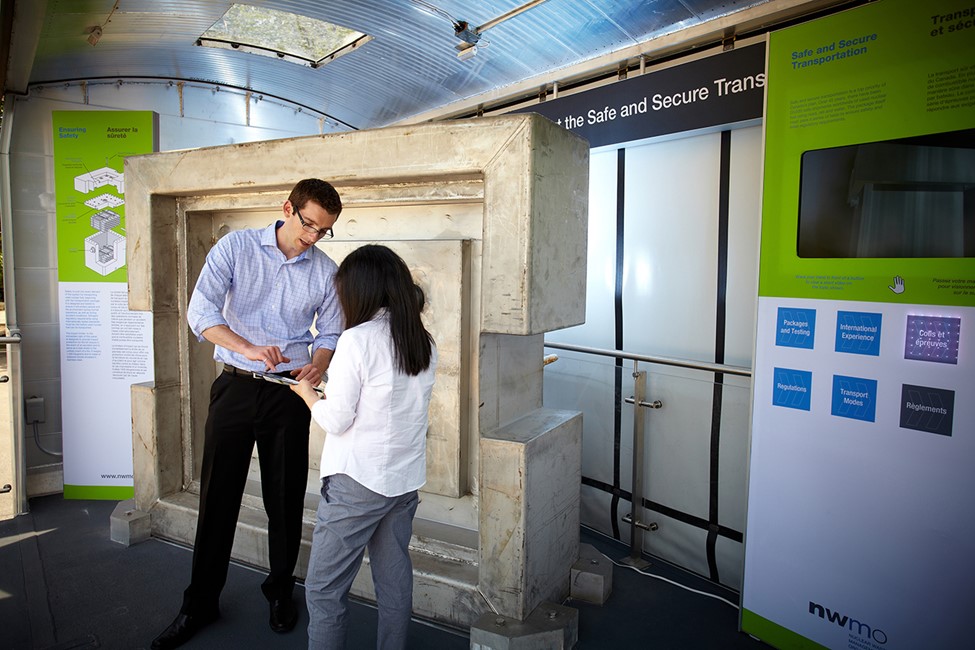NWMO transportation specialists recently gave a presentation at the Ignace Community Nuclear Liaison Committee (ICNLC) meeting on transportation planning and addressed topics from community members and others to demonstrate that used nuclear fuel can be transported safely and securely in Canada.
Transportation of used nuclear fuel from interim storage facilities to a deep geological repository is part of Canada’s plan for the safe, long-term management of used nuclear fuel. It is set to begin in the 2040s, once the deep geological repository is operational.
The NWMO’s main objective in implementing Canada’s plan is protecting people and the environment for generations to come. There is a strong international track record for transporting used nuclear fuel. In over 50 years, there have been more than 20,000 shipments worldwide of used nuclear fuel, and none have caused harm to people or the environment as a result of the release of radioactive materials. This is because of strong regulatory requirements that must be met before transportation begins.
Caitlin Burley, Transportation Engagement Manager at the NWMO, said that the NWMO is working with people to address their questions and concerns about radiation exposure during transportation and the impacts of potential accidents.
“A rigorous multi-year work program on transportation safety of used nuclear fuel is being planned. The program looks at both regulatory requirements and the concerns that people are identifying as we engage on this topic. It is very natural for people to have these concerns, and we are working to address them both at this early planning stage and over our 20-year planning time frame.”
Ms. Burley provided three case study examples of transportation accidents involving radioactive materials to acknowledge that accidents can happen, but the programs, requirements and controls around those accidents are effective at protecting people and the environment.
Darren Howe, Strategic Advisor of Waste Management at the NWMO, said that the NWMO’s transportation program takes a defence-in-depth approach – which means multiple and overlapping layers of safety measures that work together. The fundamental and first layer of protection during transportation is the transportation package. Transportation packages for used nuclear fuel are designed and tested to ensure protection of people and the environment in both normal operations and accident conditions.
In addition to the packaging design and safety requirements, there is a set of operational requirements, rigorous quality programs and best practices, including but not limited to driver training programs, vehicle and package inspections, informed decision-making prior to shipments, and monitoring of conditions prior to transport.
Yang Sui, Used Nuclear Fuel Transportation Package Design Engineer at the NWMO, spoke about the NWMO’s ability to manage the harmful impacts of radiation.
“The container that holds the used nuclear fuel weighs over 30 tons and has undergone extreme testing to simulate the most severe accident. The container has never been breached in testing.”
Those tests include dropping the container from nine metres to a solid surface, then dropping it onto a sharp object, and then placing it in a fully engulfing fire of 800 degrees Celsius for 30 minutes. The package also undergoes a water emersion tests at two different depths. These tests are designed to simulate the stresses from severe accident conditions. Videos are available on demonstration trials and testing for safety.
The focus today, approximately two decades before transportation is expected to begin, is to ensure that we can be confident that whichever site is selected to host the repository, that location will have a socially acceptable and technically sound plan. We recognize that over the 20-year planning time frame, there are many questions and concerns about transportation that will still need to be addressed.
We will continue to seek Canadians’ and Indigenous peoples’ feedback on transportation through the development of a transportation planning framework and ongoing engagement.
About the NWMO
The Nuclear Waste Management Organization (NWMO) is a not-for-profit organization implementing Canada’s plan to safely contain and isolate used nuclear fuel inside a deep geological repository in a manner that protects people and the environment for generations to come.
Canada’s plan will only proceed in an area with informed and willing hosts, where the municipality, First Nation and Métis communities, and others in the area are working together to implement it. The NWMO plans to select a site in 2024, and two areas remain in our site selection process: the Ignace area and South Bruce, both in Ontario.

